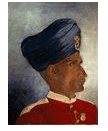Important Questions Test: When People Revolt (1857 & After) - Class 8 MCQ
15 Questions MCQ Test - Important Questions Test: When People Revolt (1857 & After)
Why did the countryside peasants and zamindars resent the British ?
Looking at the image given, pick out from the given options the one that best describes the word Sepoy?

A few statements as to why the Indian sepoys were unhappy with the British . Pick out the one that is not TRUE.
In 1824, when the sepoys were asked to go to Burma by sea route to fight for the Company, they refused to follow the order. Why ?
What was the new amendment in the law in 1856 passed by the East India Company?
Who wrote the book Majhe Pravaas?
Who was Subedar Sitaram Pande ?
Name the book written by Sitaram Pande .
From the outline map of India, name the place A, where the on 10 May 1857, a group of soldiers mutinied and walked out of their military barracks and a rebellion started
When soldiers as a group disobey their officers in the army then it is called a __________
A sequence of events that happened on 9 May 1857 are given below in a jumbled up order. Pick up the correct order from the given set of statements.
(i) Other soldiers stationed at Meerut revolted and British officers release the imprisoned soldiers.
(ii) A group of soldiers mutinied and walked out of their military barracks
(iii) The released soldiers kill the British officers and after marching to Delhi proclaim the Mughal emperor Bahadur Shah Zafar as the emperor of India
(iv) The soldiers were dismissed and sentenced to 10 years imprisonment for refusing to use the greased cartridges
Who led the revolt in Kanpur ?
Name the able commander- in chief of Nana Saheb who led the revolt in Kanpur.
Recognise this able personality from Awadh who led the revolt from Lucknow along with Maulvi Ahmadullah.
Name the Indian soldier who tried to rebel against the British at Barrackpore, but was arrested and hanged to death on 8th April 1857.



















